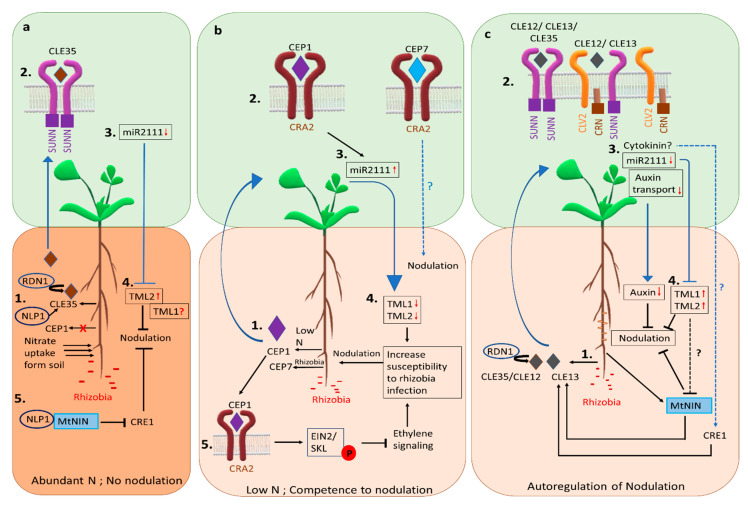Figure 2.
Mechanisms of controlling nodulation in M. truncatula. Under abundant soil N availability, plants take up nitrate from soil and do not form symbiotic nodules. (a) In response to nitrate (1), the expression of MtCLE35 is induced in the roots, dependent on the transcription factor MtNLP1. The small peptide MtCLE35 reduces nodule number systemically dependent on MtSUNN (2). This results in reduced expression of miR2111 in the shoot (3), releasing the repression of the MtTML2 transcript by miR2111 in the root (4). The reason for continued repression of MtTML1, which is also the target of miR2111, is not understood; whether MtTML1 is involved in nitrate control of nodulation is not clear (see text). Locally in the roots (5), MtNLP1 binds to MtNIN, inhibiting MtCRE1 expression to inhibit nodulation. (b) Under N limited conditions, the small peptide MtCEP1 is generated in the roots (1), which binds to the MtCRA2 receptor in the shoot (2), upregulating the expression of miR2111 in the shoot (3). Evidence suggests miR2111 is transported through the phloem to the roots, increasing the abundance of mature miR2111 in the roots. Mature miR2111 targets and lowers the transcript levels of MtTML1 and MtTML2 (4), increasing susceptibility to rhizobia and reducing AON. MtCEP1 activates MtCRA2 in the roots to phosphorylate MtEIN2, preventing its cleavage, thus repressing the ethylene response and promoting susceptibility to rhizobia (5). Another peptide, MtCEP7, generated in response to rhizobia, promotes nodulation dependent on the MtCRA2 receptor. (c) autoregulation of nodulation (AON). Rhizobial inoculation leading to nodule initiation results in the generation of MtCLE12 and MtCLE13 signaling peptides in the roots (1), which are transported in the xylem and bind to a shoot receptor complex containing MtSUNN, MtCRA2, and MtCRN (2). Together, the complex causes downregulation of miRNA2111 expression in the shoot (3). The result, perhaps through the transport of cytokinin as well as miRNA2111, is decreased miR2111 abundance in the roots and increased transcript levels of its targets MtTML1 and MtTML2 (4), inhibiting further nodulation. Another small peptide MtCLE35, which is also induced by high nitrate, controls the nodule number depending on MtRDN1 and MtSUNN in a similar manner as MtCLE12. MtNIN, involved in nodule organogenesis, also activates MtCLE13 expression to initiate AON. MtNIN might be under MtTML1 and MtTML2 regulation, maintaining a feedback control between nodule organogenesis and AON. Another potential shoot to root signal, cytokinin, may function through MtCRE1, which is required for MtCLE13 expression. Dashed lines represent proposed mechanisms; blue lines indicate systemic action and black lines indicate local events. All gene names in the figure are M. truncatula gene names, shown without the initial Mt for simplicity.

